VII - Pulmonary Resections
Editors: Shields, Thomas W.; LoCicero, Joseph; Ponn, Ronald B.; Rusch, Valerie W.
Title: General Thoracic Surgery, 6th Edition
Copyright 2005 Lippincott Williams & Wilkins
> Table of Contents > Volume I - The Lung, Pleura, Diaphragm, and Chest Wall > Section VII - Pulmonary Resections > Chapter 32 - Instruments and Techniques of Video-Assisted Thoracic Surgery
function show_scrollbar() {}
Chapter 32
Instruments and Techniques of Video-Assisted Thoracic Surgery
Alberto De Hoyos
Ricardo S. Santos
Amit Patel
Rodney J. Landreneau
BACKGROUND TO VIDEO-ASSISTED THORACIC SURGERY
Advances in video and endoscopic instrumentation and the evolution of endosurgical techniques have allowed for the rapid expansion in video-assisted operative approaches in nearly every surgical discipline. Thoracic surgery is no exception. There has been an exponential increase in the number and variety of operations now performed with video-assisted thoracic surgery (VATS) techniques, as recently reviewed by Roviaro and colleagues (2002) and by Yim (2002). VATS has pervaded the practice of general thoracic surgery, just as laparoscopic approaches now dominate many aspects of general surgery (Table 32-1).
VATS has evolved from the simple pleural diagnostic procedure, thoracoscopy. As Braimbridge (1993) noted, the first thoracoscopic procedure reported was performed by the Swedish physician Hans Christian Jacobeus (1910). He used a primitive rigid cystoscope to explore the pleural space and to facilitate the collapse therapy for pulmonary tuberculosis popular in that era. In 1921, Jacobeus presented his experience with these techniques at the Society of Radiotherapy and Electrocauterization. There, he described a two-stick approach to examine the pleural cavity directly and to provide electrocautery to lyse the offending pleural adhesions that were preventing collapse of the lung. Jacobeus (1922, 1925) continued to practice these minimally invasive thoracic approaches throughout his career.
Thoracoscopy was a very popular intervention in the management of pulmonary tuberculosis for the next three decades. Large European clinical experiences were summarized in reports by Fourestier and Duret (1943) and Coulaud and DesChamps (1947), detailing the technique and the effectiveness of thoracoscopic intervention for pleural-based pathology. Despite this enthusiastic support for thoracoscopy in Europe, vocal and influential thoracic surgeons in the United States did much to forestall thoracoscopic intervention in North America. This criticism was led by John Alexander, a pioneer of surgical treatment for pulmonary tuberculosis and a prominent figure in American academic thoracic surgery. Alexander (1937) expressed his concern about accounts of thoracoscopic disasters occurring in the tuberculosis sanatoriums of that day. These sanatoriums were primarily staffed by physicians who did not have a surgical background or the technical support to handle the potentially life-threatening complications that could occur during these early thoracoscopic procedures.
It was the development of effective antibiotic therapy in the 1950s for tuberculosis, however, that quickly made previous invasive treatment modalities, such as induced pneumothorax and thoracoplasty, obsolete. As a result, the practice of thoracoscopy was greatly curtailed in both North America and Europe. However, European investigators, including Brandt (1978), Swierenga and associates (1974), and Bergquist and Nordenstam (1966), continued to use thoracoscopy for the diagnosis and management of selected pleural and pulmonary parenchymal processes. After a period of near abandonment of this approach over the ensuing 25 years, the development of video endoscopic technology and effective endoscopic stapling devices renewed interest in thoracoscopy, or more accurately, VATS, among the thoracic surgical community. Improved image resolution and the ability to televise the magnified view of the surgical field finally allowed others in the operating room to assist the surgeon actively. Concurrently, the development of endoscopic surgical instruments and techniques has further accelerated the evolution of thoracoscopy from a diagnostic modality to a therapeutic one. In less than 10 years, minimally invasive VATS has evolved from a concept to the preferred approach to many common thoracic surgery problems, including major surgical interventions such as pulmonary resections, mediastinal surgery, and esophagectomy, as described by Lewis and Caccavale (2000)
P.504
as well as by Luketich (2000) and Roviaro (2002) and their associates.
Table 32-1. Potential Indications for Video-Assisted Thoracic Surgery | |
|---|---|
|
The goal of VATS is to reduce postoperative pain and other postthoracotomy morbidity without compromise of the therapeutic principles of open thoracic surgery, as stressed by Li (2003) and one of us (RJL) (1992b) and respective colleagues. Successful implementation of these goals has made VATS the preferred approach for diagnostic and therapeutic interventions for many intrathoracic disease processes (Tables 32-1 and 32-2). Clinical investigations reported by one of us (RJL) and colleagues (1993b, 1993c, 1994) and by Yim (2001), Stammberger (2000), Hazelrigg (1991, 1993a, 1993b) and Kirby (1995) and their associates have objectively demonstrated that VATS has similar efficacy to open thoracotomy while providing the benefits of decreased pain-related surgical morbidity, functional disability, length of hospital stay, and postoperative cardiac arrhythmias.
This chapter reviews the instrumentation and the general operative setup required as well as the basic VATS approach strategies important in accomplishing safe and efficacious VATS procedures. The role of VATS in the management of pleural and pulmonary diseases is briefly reviewed. The reader interested in specific applications of VATS in pulmonary surgery, esophageal surgery, the mediastinum, thymectomy, or its role as a diagnostic tool is advised to refer to the respective chapters in this text.
Table 32-2. Relative Contraindications for Video-Assisted Thoracic Surgery | |
|---|---|
|
INSTRUMENTATION FOR IMAGING: THORACOSCOPES AND VIDEO IMAGING SYSTEMS
A 10-mm, 0-degree, rigid operating thoracoscope (Karl Storz Endoscopy-America, Inc., Culver City, CA) with a 5-mm biopsy channel is generally preferred to the view-only thoracoscopes and laparoscopes for most VATS procedures (Figs. 32-1 and 32-2). However, these smaller
P.505
nonoperating scopes can reduce procedure-related incisional pain such as in sympathectomy for hyperidrosis. The operating thoracoscopes allow for single intercostal access for the management and biopsy of many pleural-related problems and also potentially allow for the performance of more complex VATS interventions with one less intercostal access site, as noted by one of us (RJL) and associates (1992a, 1992b, 1993a). Furthermore, when use of the neodymium:yttrium-aluminum-garnet (Nd:YAG) laser is considered, the biopsy channel of the operating thoracoscope allows for direct end-on viewing of the laser's effect on the target pathology. For similar reasons, the 0-degree thoracoscope is preferred for most VATS procedures in our practice. With proper planning of the trocar sites, the need for the 30-degree and 45-degree angled thoracoscopes is rare for straightforward procedures but may be useful in more complex operations. Flexible and semiflexible thoracoscopes are available but are more difficult to maintain spatial orientation. Developments in optics and instrumentation have allowed the introduction of minithoracoscopes (1 to 3 mm) and a variety of instruments for application on a gamut of thoracic diseases, including pleural biopsies, pleurodesis for recurrent malignant effusions, cauterization, thoracic sympathectomies, mediastinal biopsies, pericardial windows, and traumatic pneumothorax, and for most conditions today treated with 10-mm thoracoscopes, as suggested by Lazopoulos and co-workers (2002). Potential disadvantages include inferior definition and resolution than with their larger counterparts. Their use may, however, result in less discomfort, avoidance of the need for chest tube drainage, and decreased length of hospital stay.
 |
Fig. 32-1. Ten-millimeter rigid operating thoracoscope with endoscopic suction apparatus being introduced through 5-mm biopsy channel. Note the optical interface at 45 degrees from the access of the scope. |
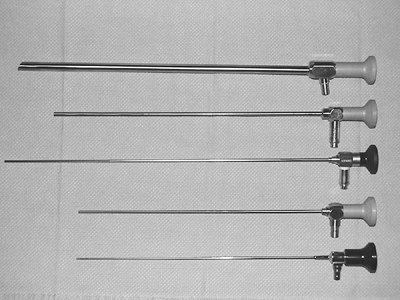 |
Fig. 32-2. Set of multiple-sized nonoperating thoracoscopes (2, 2.7, 3, 5, and 10 mm). |
A modern high-resolution three-chip CCD video camera and high-resolution video monitors are paramount to depict the operative field accurately. At the University of Pittsburgh Medical Center (UPMC), we currently use the Stryker system. Similar high-quality three-chip CCD cameras are available from other manufacturers (e.g., Olympus, Karl Storz Endovision System). The camera system is also compatible with other endoscopes used in our operating rooms, including the minithoracoscopes and the 5- and 10-mm thoracoscopes, fiberoptic bronchoscope, and fiberoptic esophagogastroduodenoscope. A photographic printer, video tape recorder, and dual high-resolution video monitors (Sony Electronics, Tokyo, Japan) complete the video endoscopic equipment setup used by our thoracic surgical team. Figure 32-3 depicts our operating room setup, the Stryker Endosuite.
The authors also use a computerized speech recognition system (Hermes). This system includes the endoscopic camera and light source, insufflator, VCR, video printer, video frame grabber, and Computer Motion's proprietary robotic devices. The system allows the surgeon to control many operating room devices using simple voice commands. Wearing a comfortable headset (Fig. 32-4), the surgeon can adjust the operating instrumentation and have access to patient's radiographs or computed tomography (CT) scans in overhead screens.
The use of three-dimensional imaging technologies for VATS procedures has been explored. Given the present technologic limitations and constraints of the three-dimensional systems, we have found little need for this technology. Visors for three-dimensional enhancement and other devices typically employed by these systems have improved significantly.
Bacchetta (2003), Morgan (2003), Ruurda (2002), and Melfi (2002) and their associates have used computer-aided robotic technology to facilitate advanced thoracoscopic procedures. Okada and colleagues (2001) reported the thoracoscopic resection of peripheral carcinoma of the lung by a single surgeon with a voice-controlled robot.
A recent addition to the exchange of information and technical expertise is the use of real-time telestration.
P.506
Through the use of remote telestration similar to the line drawings used by television football announcers rehearsing a football play, an expert surgeon at a remote monitor with this capability can have his linear instructions transported electronically to the video monitor during the conduct of the operation. Split-screen and still-frame monitor application further enhance these remote instructional capabilities.
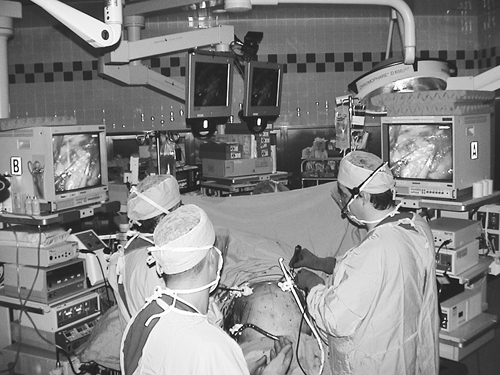 |
Fig. 32-3. Operating room setup depicting the interactive video system and Hermes command modules. |
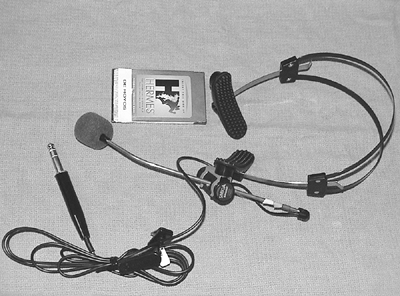 |
Fig. 32-4. Hermes microphone headset with computer connection. Physician-specific voice recognition computer chip card is also demonstrated. |
Modalities for Tissue Coagulation: Electrocautery, Ultrasound, Laser
Monopolar electrocautery (Valleylab Inc., Boulder, CO) is used during VATS for simple dissection and coagulation in fashion similar to open surgery. Bipolar electrocautery is seldom necessary in VATS. However, bipolar electrocautery is indicated in cases in which VATS is chosen to approach paraspinous pathology (e.g., thoracic intervertebral disc disease, paraspinous neurogenic tumors) to avoid injury to central nervous system tissue. At present, the argon-beam coagulator (ABC; Birtcher Medical Systems, Irvine, CA) is uncommonly used in VATS, although its use has been advocated by some as a means to achieve pleural symphysis thermally. The ABC differs from standard electrocautery in that it uses a stream of inert argon gas that blows away fluids and conducts the electrocautery current into a broader beam. These effects have made the ABC a useful tool in coagulating broad surfaces and solid-organ parenchyma. Applications of the ABC in VATS include when pleural symphysis is desired (treatment for pneumothorax, pleural effusion) and to facilitate lung volume reduction through superficial cauterization and shrinkage of subpleural bullous emphysema. Results with the ABC in these settings have been good but not outstanding because of the high incidence of prolonged air leaks, as reported by Lewis and colleagues (1993). In a study by Sawabata and associates (1996), the ABC was found to induce a significant amount of destructive coagulation on the pleural surface, leading to subsequent air leaks.
The ultrasonic dissector-coagulator (Harmonic Scalpel/ UltraCision LCS-Pistol Grip, 5 mm, Ethicon Endo-Surgery, Inc., Cincinnati, OH) performs on a different principle than electrocautery. Instead of applying a current of high-frequency AC electricity, the Harmonic Scalpel uses 50-kHz oscillations that are physically transmitted to the tissues in the grasp of the shears or the tip of the scalpel. This creates the intracellular and extracellular vibrations that result in heat and coagulation of the tissue. One important advantage of the Harmonic Scalpel is that there is little threat of injury to adjacent tissue outside the grasp of the forceps's jaws or the tip of the Harmonic Scalpel. Hemostasis is reliable, even when dividing blood vessels of 3 or 4 mm in diameter. Coagulation is effective in sealing the vessels with a minimal incidence of delayed bleeding. By obviating the need for individually clipping and dividing small vessels, the operation may be expedited. A 5-mm Harmonic scalpel has recently been introduced and is the preferred instrument for most VATS procedures (Fig. 32-5).
The primary role of electrocautery in VATS is division of simple pleural adhesions and dissection of hilar structures. Electrocautery alone is inefficient and potentially inappropriate for division of pulmonary parenchyma or larger parenchymal blood vessels. Liberal use of electrocautery to divide the fissures may result in prolonged air leaks and hospitalization. The authors use the Harmonic Scalpel extensively during the thoracoscopic and laparoscopic portions of minimally invasive esophagectomies, as described by Luketich and associates (2000). The use of the 1064-nm Nd:YAG laser as a tool for resection of selected pulmonary lesions has been described by our group, as reported by one of us (RJL) (1991a, 1991b, 1992a, 1992b, 1992c, 1993d) and LoCicero (1989) and respective colleagues. Indeed, until the advent of the endoscopic stapling devices, Nd:YAG laser lung resection was a common modality employed for parenchymal-sparing excision of pulmonary nodules. The Nd:YAG laser can function
P.507
as a primary (or adjunctive) resective and coagulative tool for pulmonary resection and is the most versatile laser available for VATS applications presently available. It has been found to have superior hemostatic and pneumostatic coagulation properties compared with CO2 lasers in reports by LoCicero and colleagues (1985, 1989) and one of us (RJL) and associates (1991a, 1991b, 1992a, 1993d).
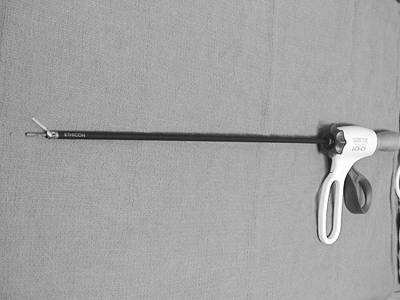 |
Fig. 32-5. Five-millimeter harmonic scalpel. Its use expedites dissection of tissues and coagulation of small blood vessels less than 3 mm in diameter. |
Lung resection with the Nd:YAG laser is effective but is slow and tedious. Moreover, there is a significant learning curve in becoming proficient with the techniques of VATS laser for pulmonary resections. Hence, most thoracic surgeons have lacked enthusiasm for this approach. Since the widespread introduction of stapling devices, the use of laser during VATS procedures has been limited to centers with a high volume of complex pulmonary surgery. Presently, the role of the Nd:YAG laser in pulmonary resection is limited, but it is perhaps most useful in patients with poor pulmonary reserve in whom maximal parenchymal sparing is desired. As noted by Keenan (1995), one of us (RJL) (1993d), and LoCicero (1989) and respective colleagues, the adjuvant use of the Nd:YAG laser to stapled techniques (Fig. 32-6) may facilitate resection from difficult locations, such as the flat surface of the lower lobe, or when the nodule is deep within the substance of the lung parenchyma.
Stapling Devices
The development of effective and reliable endoscopic stapling devices revolutionized and accelerated the application of VATS for pulmonary diseases, as outlined by Acuff and co-workers (1993). The endoscopic stapling devices are generally easy to use and reliably divide pulmonary parenchyma and vessels while maintaining excellent hemostasis and pneumostasis. Commonly available models include the EVC/ELC (endoscopic linear) staplers from Ethicon (Cincinnati, OH) and Endo-GIA from U.S. Surgical (Norwalk, CT). A variety of staple sizes and stapler lengths are presently available (Table 32-3). The one-grip design, such as the Ethicon EZ-45, allows the apposition of the stapler jaws and the application of the staples without the need for the surgeon to change the grip. Reticulating stapler designs are now available from U.S. Surgical and Ethicon and are of benefit in certain instances. We generally employ the linear 30- or 45-mm stapler loads in pulmonary surgery. The Endo-GIA Universal XL stapler combines the proprietary attributes of the standard Endo-GIA Universal stapler interchangeable multiple length cartridges, six rows of staples, tissue gap control, and a new knife blade with each cartridge in a 10-cm longer delivery package.
Although 60-mm stapler loads are available, Worsey and one of us (RJL) (1998) noted that the jaws of the device open only slightly wider, making these 60-mm instruments more difficult to use compared with the 30- and 45-mm devices. In addition to their efficacy and reliability in performing lung resection, they are very useful in dividing hilar vascular structures, as in VATS lobectomy.
Buttressing of staple lines has been achieved with bovine pericardium (Peri-Strips Dry; Bio-Vascular, Inc., St. Paul, MN), with polytetrafluoroethylene (PTFE, Gore-Tex) and,
P.508
more recently, with a bioabsorbable product (Seamguard, Gore & Associates, Inc., Flagstaff, AZ) (Fig. 32-7). The bioabsorbable product is a porous fibrous structure composed solely of synthetic bioabsorbable polyglycolide-trimethylene carbonate copolymer. The copolymer components have been used in absorbable suture materials (Vicryl and Maxon) and can be expected to retain measurable mechanical strength for 4 to 5 weeks. In vivo studies indicate that the bioabsorption process should be complete by the end of 6 months. This product can be used for both the blue and green stapler loads. The main use of these products is to decrease the duration of air leaks, chest tube drainage, and length of hospital stay. Most of the accumulated experience derives from their application in lung volume reduction surgery.
Table 32-3. Specifications of Commonly Used Thoracoscopic Staplers | |||||||||||||||||||||||||||||||||||||||||||||||||||||||||||||||
|---|---|---|---|---|---|---|---|---|---|---|---|---|---|---|---|---|---|---|---|---|---|---|---|---|---|---|---|---|---|---|---|---|---|---|---|---|---|---|---|---|---|---|---|---|---|---|---|---|---|---|---|---|---|---|---|---|---|---|---|---|---|---|---|
| |||||||||||||||||||||||||||||||||||||||||||||||||||||||||||||||
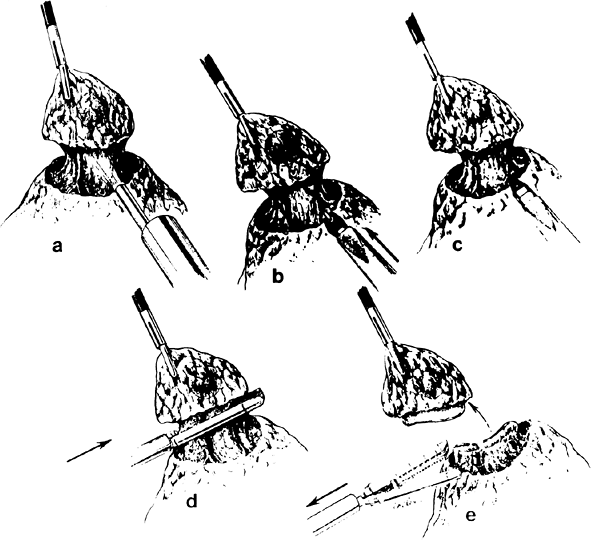 |
Fig. 32-6. Technique of combining application of the Nd:YAG laser and endoscopic stapler for pulmonary wedge resection. From Landreneau RJ, et al: Thoracoscopic resection of 85 pulmonary lesions. Ann Thorac Surg 54:415 420, 1992a. With permission from the Society of Thoracic Surgeons. |
Hand-held Instruments and Instrument Design
The explosion in endoscopic or minimally invasive surgery in North America and Europe has fueled industry to invest in the development of both disposable and reusable hand-held instruments and accessory operative instrumentation. Although a vast array of plastic disposable instruments and trocars are available, reusable models of thoracoscopy ports and other instruments, such as retractors, graspers, and clamps, can be used. Most surgeons acquire reusable endoscopic surgical instruments when their VATS case volume justifies the cost of acquiring reusable instruments (Fig. 32-8). Presently available reusable endoscopic scissors are frequently subject to rapid dulling of the scissor blades or loosening of the hinge mechanism. This results in deterioration of the scissoring action, rendering the instrument ineffective. Some companies have developed endoscopic scissors (Snowden Pencer, Atlanta, GA) with replaceable ends that incorporate a new set of scissor blades and hinge. This concept can overcome the limitations of the endoscopic scissors mentioned at a reduced additional cost and may be preferable to the plastic disposable endoscopic scissors.
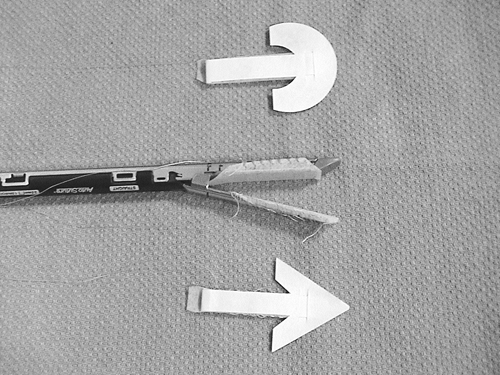 |
Fig. 32-7. Bioabsorbable staple line reinforcement material (Seamguard, Gore & Associates, Inc., Flagstaff, AZ). For proper orientation purpose, the company has differently fashioned the two sides of the buttressing: the arrowhead configuration is placed on the anvil side of the staple mechanism, and the mushroom configuration is placed on the cartridge side. |
A central problem facing the surgeon performing VATS relates to the inadequate instrument design inherent to the pistol-grip endosurgical instruments. Although the pistol-grip design works well for some applications, such as endoscopic
P.509
staplers, they are awkward to use for detailed manipulation and dissection of tissues. As a result, some surgeons have adapted the use of standard thoracic surgery instruments through a utility or limited thoracotomy access incision. Coaxial endosurgical instruments that allow for unimpeded access through the intercostal port have been developed by Starr Medical Instruments (New York, NY) and Pilling Surgical (Horsham, PA) (see Fig. 32-8). Instruments such as the Landreneau mashers retain the feel of standard open surgical instruments and replicate many of the familiar standard graspers and forceps while requiring a minimal intercostal access incision (Fig. 32-9A-D). The hand orientation of coaxial endosurgical instrumentation, similar to that of standard open surgical hand tools, can facilitates the acceptance of VATS approaches and the versatility of thoracic surgeons otherwise disinclined to take on these minimally invasive techniques.
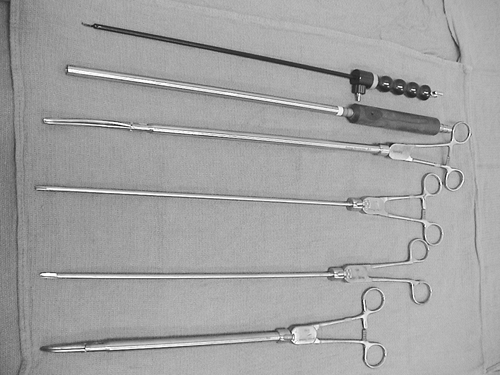 |
Fig. 32-8. Set of reusable surgical instruments commonly used in video-assisted thoracic surgery. (Landreneau Mashers and Hoover suction device, Pilling, Horsham, PA, USA). |
BASIC VIDEO-ASSISTED THORACIC SURGERY OPERATIVE STRATEGIES
The first maneuver is proper patient selection for the operation, as described by one of us (RJL) and colleagues (1992a, 1992b, 1992c) and by Meyer (2000). As with any major operative procedure, a careful assessment of the patient's
P.510
physiologic reserve is mandatory, as stressed by Wernly and DeMeester (1989) and recently outlined by Melendez and Fischer (1997) and Teplick (1997). Another major preoperative concern facing the thoracic surgeon beginning VATS is determining the adequacy of anesthesia team support that is available in their hospital, as described by Low (2000). It is vital that anesthesia personnel be experienced in open thoracic procedures and the principles and applications of selective single-lung ventilation during the operation, as described by Benumof (1983). VATS procedures cannot be accomplished without sufficient unilateral pulmonary atelectasis. Therefore, it is crucial that the anesthesia team is well acquainted with double-lumen endotracheal intubation, bronchial blockers, and other techniques, as reviewed by Wilson (1997), to achieve single-lung ventilation as well as the physiologic support required during single-lung ventilation. Invasive intravascular monitoring is used as determined by the patient's cardiovascular status and comorbidities.
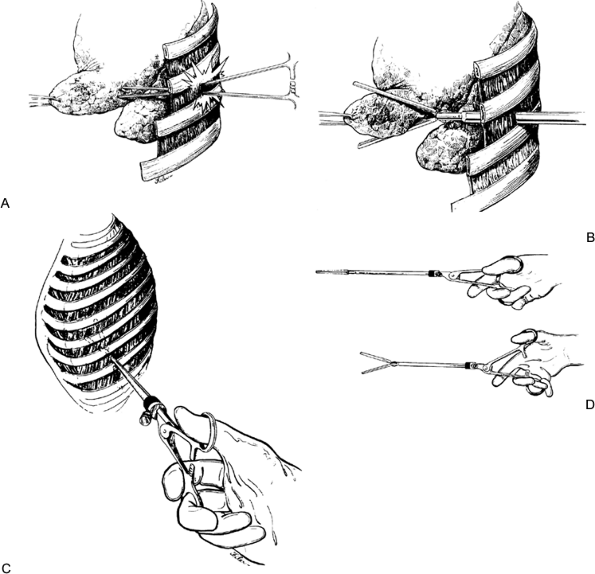 |
Fig. 32-9. A. Narrow intercostal space prevents use of standard open instruments. B-D. Coaxial thoracoscopic instruments allow use of small port incisions while retaining instrument feel of standard open instruments. |
Patients with bulky anterior and middle mediastinal masses impinging on the airway may represent an anesthetic challenge during induction or conduct of anesthesia. A reduction in tracheal cross-sectional area of more than 35% by CT scan indicates an increased risk during anesthesia; similarly, reduced pulmonary flow mechanics with distortion of the flow-volume loop are a sensitive indicator of functional airway compression and susceptibility to intraoperative airway compromise. Recommendations for anesthetic management include: (a) fiberoptic evaluation of the tracheobronchial tree for evidence of severe extrinsic compression; (b) induction of anesthesia in a semierect position, with the option of changing to a lateral or prone position quickly if necessary; (c) use of uncut long endobronchial tubes that can be advanced beyond the site of obstruction; (d) ready availability of a ventilating rigid bronchoscope to establish and maintain an adequate airway; (e) avoidance of muscle relaxants and use of spontaneous ventilation whenever possible; (f) lower extremity intravenous access cannulation to provide access to the systemic circulation if a sudden superior vena caval obstruction should occur; and (g) standby cardiopulmonary bypass with bilateral groin cannulation in patients at high risk.
Intraoperative bronchoscopic examination is important to rule out the presence of endobronchial pathology. After placement of the double-lumen endotracheal tube is confirmed, the patient is positioned in a full lateral decubitus position with appropriate padding and with the operating table extended to maximize the intercostal distances on the operative side. The patient should be safely secured to the table to allow for any table position changes needed. The thorax is prepared and draped for open thoracotomy should this necessity arise. It is vital that the surgical team preparing to perform VATS interventions be personally familiar with standard thoracic surgical procedures. Many VATS procedures share the same potential intraoperative complications as its thoracotomy counterpart; accordingly, VATS procedures should be performed in an operating room where facilities for immediate conversion to thoracotomy are available.
A careful preoperative review of the pathology by chest radiography and CT scan is vital to formulate the plan for the initial and subsequent intercostal access for the thoracoscopic and surgical instruments. Furthermore, as one of us (RJL) and colleagues (1992b, 1993a) have outlined previously, the patient's specific anatomy is an important consideration when planning the approach. For example, for a VATS-directed wedge biopsy of the lung for diffuse interstitial disease, a right-sided approach is preferred. Because of the trilobar anatomy of the right lung, there are more edges to obtain wedge biopsies from. On the other hand, a left-sided approach is advised for bilateral diffuse nodular disease. This is due to more reliable and complete collapse that can be achieved on the left side, which is important in identifying the discrete nodules for biopsy. The left-sided approach for lung biopsy is also preferred in smaller patients, in whom double-lumen endotracheal intubation may not be possible and bronchial blockers are employed.
Similarly, because of anatomic considerations, we have altered our approach for VATS thymectomies. A left-sided approach was initially described by one of us (RJL) and co-workers (1992c) and used by Mineo and associates (2000) for better pulmonary collapse and visualization of the aortopulmonary window lymph nodes. However, with further experience, it was found that troublesome bleeding could arise at the region near the superior vena cava and innominate vein that is difficult to address from the left chest. A right-sided or bilateral approach, as described by Mantegazza and colleagues (2003) and by Yim (2002), allows clear visualization of this region during dissection and is now our preferred approach to VATS thymectomy. In addition, the bilateral approach also allows easy access to predominant left-sided thymic pathology.
The operation is begun by choosing an appropriate intercostal site of access for exploratory thoracoscopy. The skin incision is made directly over the intercostal space to be entered, as opposed to the traditional tunnel made for simple tube thoracostomy placement. This allows for increased mobility of the port and reduces the incidence of postoperative intercostal neuritis secondary to excessive torquing of the thoracoscope against the rib cage and intercostal neurovascular bundle, as outlined by one of us (RJL) and associates (1992b, 1993a). Careful introduction of a small curved pointed clamp (e.g., Kelly or Crile) through the intercostal muscles and pleura is made along the superior border of the lower rib of the intercostal access site chosen to minimize injury to the intercostal vessels and nerve. The clamp is opened to widen the intercostal space. Direct digital exploration of the intercostal access site, rather than blind trocar placement into the chest, is used to identify the presence of local pleural adhesions and avoid injury to the underlying lung. Pleural adhesions to the lung can impede the introduction of instruments and potentially result in pulmonary parenchymal injury. Flimsy local adhesions can be
P.511
divided with blunt finger dissection. More extensive pleural symphysis in the location of the proposed initial access site may require alternative intercostal access to conduct the VATS procedure. Hemostasis of the port site should be meticulous because even small amounts of bleeding will dribble down the trocar and onto the thoracoscope lens, interfering with the view during the procedure.
Table 32-4. Strategic Approach to Intrathoracic Pathology at Specific Locations | |||||||||||||||||||||||||||||||||||||||||||||||||||||||
|---|---|---|---|---|---|---|---|---|---|---|---|---|---|---|---|---|---|---|---|---|---|---|---|---|---|---|---|---|---|---|---|---|---|---|---|---|---|---|---|---|---|---|---|---|---|---|---|---|---|---|---|---|---|---|---|
| |||||||||||||||||||||||||||||||||||||||||||||||||||||||
In general, the sixth or seventh intercostal space in the midaxillary line is ideal for trocar-protected thoracoscope access to the pleural cavity. This initial thoracoscope location usually provides a clear view of the mediastinum, all pleural surfaces, and the pulmonary parenchyma. The intercostal-access trocar tube is important to prevent soiling the thoracoscope lens surface during the introduction and variable positioning of the thoracoscope during the operation. Agents such as FRED (Dexide, Inc., Fort Worth, TX) can be applied to the lens to reduce lens fogging. Prewarming of the thoracoscope in a warm-water bath (Circon Co., Santa Barbara, CA) will further reduce lens fogging from condensation by reducing the temperature differential between the warm, moist air within the pleural cavity and the cooler thoracoscope. A less expensive alternative is the use of diluted povidone-iodine (Betadine) solution as a defogging agent.
Carbon dioxide insufflation is rarely needed to conduct VATS. Occasionally, this is used at the beginning of the procedure to facilitate a more complete and expeditious collapse of the lung. If carbon dioxide insufflation is used, the intrapleural pressure is kept below 5 mm Hg to avoid mediastinal tension and hemodynamic instability. Carbon dioxide insufflation is also used during single- or double-port access sympathectomy. The visibility of the entire thoracic cavity obtained through the VATS approach contrasts favorably with the confined direct view of the intrathoracic structures obtained through a limited axillary, inframammary, or lateral thoracotomy. After the initial thoracoscopic exploration of the pleural cavity is concluded, further intercostal access for VATS instrumentation is achieved under direct thoracoscopic vision.
The specific locations of the additional port sites are determined by the site of the primary pathology (Table 32-4). In general, the ports are strategically placed around the thorax to allow for some working room between the port and the lesion. The endoscopic instruments and the thoracoscopic camera should be oriented so that they all are being used to face the target pathology from the same direction (Fig. 32-10); otherwise, difficulties in instrument manipulation will occur as a result of mirror imaging when the instruments are directed toward the thoracoscopic camera. In addition, it is important to keep in mind that the interspaces are larger anteriorly, allowing more room to maneuver and
P.512
decreasing the possibility of injury to the intercostal nerves. It is paramount to conceptualize the three-dimensional location of the target lesion within the thorax, then place the port access sites to triangulate on the lesion. With proper port placement resulting in an adequate distance between the ports, fencing of the instruments can be avoided, and enhancement of the surgeon's spatial perception of the operative field is achieved. In addition to the thoracoscope, trocar ports are required to protect endoscopic staplers during their insertion into the thorax. On the other hand, other instruments, such as graspers and suction devices, do not require a trocar port, and increased instrument mobility can be gained by omitting the port. Strategic positioning of the thoracoscopic camera and the endoscopic instruments is vital to the success and efficiency of the procedure (Table 32-5).
 |
Fig. 32-10. Baseball diamond concept for triangulation of the instruments and thoracoscope for strategic visibility and manipulation of the target pathology. From Landreneau RJ, et al: Video-assisted surgery: basic technical concepts and approach strategies. Ann Thorac Surg 54:800, 1992b. With permission. |
Table 32-5. Basic Video-Assisted Thoracic Surgery Operative Concepts | |
|---|---|
|
Excessive torque should be avoided when manipulating the instruments in VATS to avoid damaging the instruments as well as the complications of postoperative intercostal neuritis (Fig. 32-11). For simple biopsy procedures, a two-stick approach using a grasper through the operating thoracoscope will often suffice (Fig. 32-12). This technique often requires alternating the positions of the thoracoscope and the stapler to facilitate the wedge resection (Fig. 32-13). If the view is inadequate or if the angle of the instrument is inappropriate for the desired manipulation, options include alternating the port sites or establishing a more favorable site of intercostal access for a three-stick approach (Fig. 32-14). Sometimes, by changing or alternating the location of the instruments and thoracoscope, a different
P.513
perspective can be gained to achieve the task at hand. Finally, conversion to a limited or utility thoracotomy or to a standard open thoracotomy is wise if compromise of the patient's diagnostic and therapeutic intent is jeopardized.
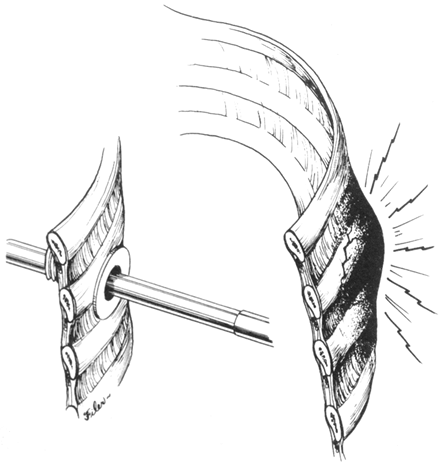 |
Fig. 32-11. The trocar-protected intercostal access site for thoracoscopic introduction, illustrated as a potential site of intercostal neuronal injury and rib fracture due to excessive torquing of the instrumentation at the interspace. From Landreneau RJ, et al: Prevalence of chronic pain following pulmonary resection by thoracotomy or video-assisted thoracic surgery. J Thorac Surg 107:1079, 1994. With permission. |
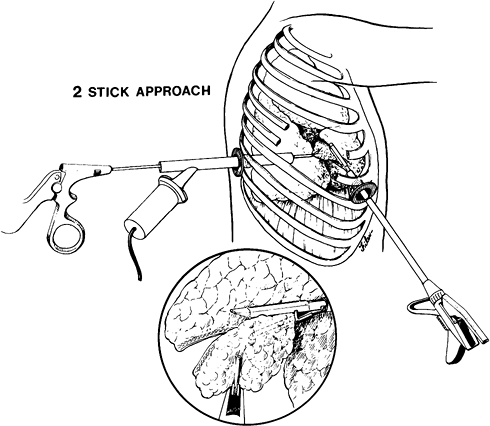 |
Fig. 32-12. Two-stick thoracoscopic lung biopsy approach. Inset depicts videoscopic view of the grasping instrument as it appears through the biopsy channel of the operating thoracoscope and the endoscopic stapling device crossing beneath the grasped lung tissue. From Ferson PF, et al: Thoracoscopic vs. open lung biopsy for the diagnosis of infiltrate lung disease. J Thorac Cardiovasc Surg 106:194, 1993. With permission. |
Manipulation of the operative table is also important in the course of a VATS procedure. Typically, the table is rotated posteriorly to expose more of the anterior thorax for most cases. For cases involving an anterior lesion, a more posterior approach is achieved by rotating the table anteriorly and placing the ports more posteriorly. The use of Trendelenburg's position and reverse Trendelenburg's position is also helpful to allow gravity to keep the lung out of the operative field. To minimize muscular tension and fatigue in the surgeon's arms and hands, the operating table should be lowered so that the handles of the instruments are
P.514
at the level of the surgeon's elbow or slightly lower, thereby keeping the surgeon's wrists in neutral position and the elbows in slight extension (elbows held slightly beyond 90 degrees).
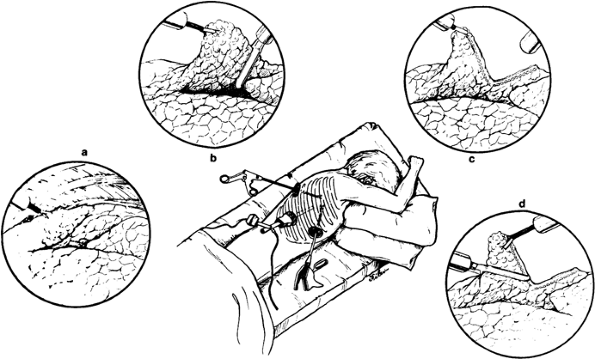 |
Fig. 32-13. Serial application of the Endostapling device to accomplish a standard V-wedge resection of the lung with a three-stick technique. Note that the intercostal access position of the stapling device and the grasping instruments are reversed to complete the stapled wedge resection expeditiously. From Dowling RD, et al: Thoracoscopic wedge resection of the lung. Surg Rounds 16:341, 1993. With permission. |
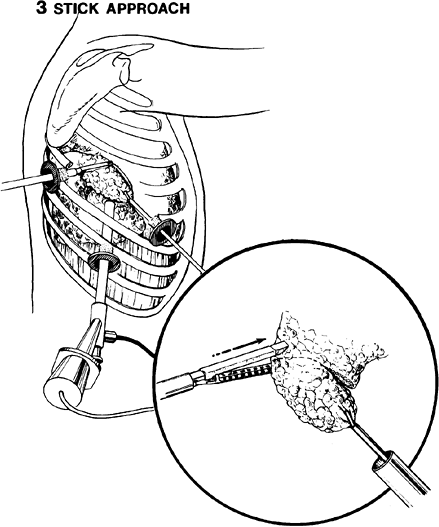 |
Fig. 32-14. Drawing of intercostal access typically used for a three-stick intercostal access approach for video-assisted thoracic surgery wedge resection of the lung using the endoscopic stapling device. From Ferson PF, et al: Thoracoscopic vs. open lung biopsy for the diagnosis of infiltrate lung disease. J Thorac Cardiovasc Surg 106:194, 1993. With permission. |
Approach to the Indeterminate Pulmonary Nodule
The differential diagnoses and the diagnostic approaches for the indeterminate solitary pulmonary nodule have been recently reviewed by Lillington (2001) as well as by Ost (2003) and Tan (2003) and their associates and are discussed in Chapter 93. The malignant potential of indeterminate solitary pulmonary nodules mandates accurate diagnostic management. In a study by Mitruka and our group (1995), the accuracy of fine-needle aspiration (FNA) for malignant nodules was 86%. However, a specific benign diagnosis was obtained in only 30% of patients, thus leaving the diagnosis in doubt in most patients with nonspecific benign biopsy results from percutaneous biopsy. A significant percentage of these patients will ultimately be found to have malignant lesions upon surgical biopsy. Accordingly, false-negative FNA may unnecessarily delay the diagnosis and management of the patient's lesion. There is also the known procedure-related pneumothorax rate of 25% associated with percutaneous biopsy and the increased overall number of days of hospitalization for the patient ultimately found to have a malignant lesion. A positive malignant diagnosis merely confirms the clinical impression of the lesion. Logic follows that among good-risk patients, a positive diagnosis requires surgical resective management. Furthermore, a nonspecific negative diagnosis also requires strong consideration for surgical excisional biopsy because of the significant false-negative rate in this clinical setting.
Of course, the development of positron emission tomographic (PET) scanning technology has put an additional wrinkle in the management algorithm of the indeterminate solitary pulmonary nodule. Among lesions large enough to be discriminated by present-day PET, it is generally believed that a negative scan has significant predictive value. False-negative PET scans, however, can be seen among bronchioalveolar carcinomas and neuroendocrine neoplasms.
In contrast to the results of percutaneous biopsy, a specific benign or malignant diagnosis for the indeterminate nodule can be anticipated with the VATS excisional biopsy approach in 96% of the patients. Frozen-section pathologic diagnosis is obtained while the patient is under anesthesia. If a malignant diagnosis consistent with primary lung cancer is determined, definitive oncologic management of the malignancy is performed. When a benign pathology is found, no further surgery is necessary, and the need for long-term radiographic surveillance is usually avoided. Discharge from the hospital can be anticipated within 48 hours among patients with benign pathology undergoing simple wedge resection of the peripheral pulmonary lesion. Based on this information, it is the authors' belief that VATS excisional biopsy of the indeterminate solitary pulmonary nodule can often expedite the management of the patient and avoid the expense and potential complications related to percutaneous biopsy.
Table 32-6. Criteria for Video-Assisted Thoracic Surgery Resection of Pulmonary Nodule | |
|---|---|
|
In general, indeterminate lung nodules ideally suited for thoracoscopic excisional biopsy are those less than 3 cm in diameter located in the outer third of the lung parenchyma. There should also be no evidence of endobronchial extension on preoperative bronchoscopic evaluation. Some deeper lesions identified on CT imaging, found to be on an edge of an interlobar fissure at VATS exploration, may also be candidates for VATS excisional biopsy (Table 32-6; Fig. 32-15).
Attempting to resect a deep lesion may result in parenchymal injury leading to physiologic deterioration equivalent to lobectomy. Application of endoscopic staplers through the thicker tissue of the lung can also lead to intraparenchymal hematoma, staple-line disruption, and the possibility of delayed bronchopleural fistulae. Such deep nodules may be best handled using intraoperative needle biopsy. Anatomic resection (i.e., segmentectomy or lobectomy) should usually follow when malignancy is confirmed. On some occasions, lesions can also be handled by the judicious combined application of staplers and Nd:YAG laser resection, as reported by Dowling (1993) and Keenan (1995) and their associates.
It may be difficult to identify small peripheral solitary pulmonary nodules using VATS techniques. Lesions that are particularly difficult to palpate or visually localize are those of subcentimeter diameter and located some distance
P.515
beneath the pleural surface. There are several techniques that greatly facilitate VATS when employed for nodular processes of the lung, as Mack and associates (1993) and one of us (RJL) and colleagues (1993a) have detailed. Foremost, the thoracic surgeon developing skill with these VATS excisional biopsy approaches will find it useful to review critically the anatomic detail of the lesion and its relationship to the lobar anatomy visualized on CT imaging.
 |
Fig. 32-15. Indeterminate lung nodule ideal for resection by video-assisted approach. |
It is also crucial to accomplish ipsilateral lung collapse through selective ventilation with double-lumen intubation or bronchus-blocking techniques. The thoracic surgeon should participate with the anesthesia team in the inspection of the airway control measures before positioning the patient for the VATS intervention. Several maneuvers may aid in deflating the lung completely to allow better surface definition of the nodular lesion. Pleural adhesions hindering adequate pulmonary parenchymal collapse should be lysed by sharp dissection or electrocautery as necessary. With collapse of the pulmonary parenchyma, most pleural- and subpleural-based nodules 1 cm or greater in size should be evident. Smaller nodules or nodules situated deeper in the lung parenchyma may reveal themselves as a subtle puckering of the visceral pleural surface. A sweeping motion with a blunt instrument over the surface of the lung parenchyma where the lesion is suspected may reveal the mass as a slight irregularity in the texture of the lung. Finally, if these maneuvers are unsuccessful, the lung can be elevated toward the chest wall with a lung clamp, and direct digital palpation of the suspected area of the lung can be performed through one of the other port sites.
In cases in which difficulty in locating the lesion is anticipated, Mack (1993) and Schwartz (1994) and their co-workers have suggested that a preoperative CT-guided needle localization or dye injection may be a useful adjunct. Recent reports by Partik (2003) and Dendo (2002) and their associates support the use of a dedicated helical lung marker or a short hook wire for localization of small peripheral lung nodules under CT guidance before thoracoscopic resection (Fig. 32-16).
Jimenez (2001), as well as Cardillo (2003), Burdine (2002), and Ginsberg (1999) and their colleagues, recently reported their experience with VATS resection of pulmonary nodules. It is well established that the probability of malignancy for a particular solitary pulmonary nodule increases with the size of the lesion, the age of the patient, a history of a previous cancer, and the need for thoracotomy to locate the nodule. The increasing use of low-dose radiation, high-resolution CT scan as reported by Nakata and colleagues (2003) has led to earlier detection of lesions previously undetectable at such an early stage of their evolution. A specific problematic area involves the detection of ground-glass opacities. In their study of VATS resection of ground-glass opacities, Nakata and colleagues (2003) reported that pure ground-glass opacities 1 cm or less in diameter were characteristic of bronchoalveolar carcinoma or adenomatous hyperplasia, whereas larger or mixed ground-glass opacities were typical of adenocarcinomas. At a median follow-up of 18 months, there was no evidence of tumor recurrence in any patient after thoracoscopic resection of pure ground-glass opacities. This preliminary experience suggests that thoracoscopic wedge resection with generous, clear surgical margins may have a role as a definitive therapeutic modality for selected ground-glass opacities ultimately found to be malignant.
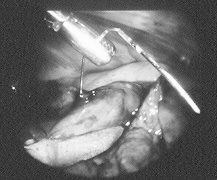 |
Fig. 32-16. Hook wire localization technique. The wire is placed before surgery in the radiology unit under computed tomographic imaging to guide the surgeon localize the nodule intraoperatively. |
Approach to Interstitial Lung Disease
The differential diagnosis of interstitial lung disease includes more than 100 diagnoses (see Chapter 94). A practical approach to managing these patients is to obtain a detailed history and physical examination, lung imaging studies, bronchoscopic examination with analysis of bronchoalveolar fluid, blood serology, and pulmonary function evaluation. If the specific etiology remains unknown, tissue sampling is necessary to establish a diagnosis and to identify potentially treatable causes.
Lung tissue may be obtained by open or thoracoscopic approaches. VATS is becoming the more commonly accepted procedure for most clinical situations, as demonstrated by Ferson and associates (1993) and recently reviewed by Allen (2000). An open procedure is, however, recommended in the presence of contraindications to VATS such as inability to tolerate single-lung ventilation. Other potential contraindications include significant pulmonary hypertension and coagulopathy. Miller and co-workers (2000) and Ayed and Raghunathan (2000) compared VATS with open-lung biopsy and found similar outcomes, with no difference in postoperative pain, narcotic requirements, operating room time, adequacy of biopsy,
P.516
duration of chest tube drainage, length of stay, spirometry, or complications.
Kadokura and associates (1995) analyzed the pathologic results of patients undergoing lung biopsy by these two different techniques and concluded that both procedures had comparable results in patients undergoing biopsy for pulmonary infiltrates or indeterminate nodules.
Biopsies from different lobes should be obtained whenever possible to provide good representation of the pathologic process under investigation. Ayed and Raghunathan (2003) and Temes and colleagues (2000), contrary to common belief, have provided evidence that the lingula is an appropriate site for lung biopsy. Buttressing of the staple line is not routinely necessary but may be recommended for patients considered at high risk such as those requiring positive-pressure ventilation and in the presence of accompanying emphysematous lung. Most patients require a short period of hospital stay, although Chang and associates (2002) have reported their experience with outpatient VATS biopsy.
Chest Tubes
At the conclusion of the VATS operation, one or more of the intercostal access sites are used for chest tubes in most patients. The proper placement of the chest tubes is confirmed by thoracoscopy before termination of the procedure. The remaining intercostal access sites are closed in layers, ensuring an airtight closure. However, in the extremely thin patient, the chest tubes may have to be placed through separate incisions using the standard oblique subcutaneous tunnel to avoid a subsequent air leak when the chest tube is removed. Administration of a long-acting local anesthetic (e.g., 0.25% bupivacaine) at the intercostal sites is helpful with postoperative pain management. Russo (1998) and Chang (2002) and their colleagues reported on the safety and efficacy of early removal of chest tubes in the immediate perioperative period following elective VATS stapled wedge resection of the lung. The former authors demonstrated a reduction in length of hospital stay, postoperative pain, and the number of chest radiographs taken by early removal of chest tubes following the criteria noted in Table 32-7. Chest tubes were typically removed in the recovery room within 90 minutes of the operation. There was no difference in the incidence of pneumothorax or pleural effusion after removal of the chest tube. No patient required reinsertion of a chest tube.
Table 32-7. Criteria for Early Removal of Chest Tube | |
|---|---|
|
Extraction of Tissue Specimens
Removal of pathologic tissues from the thoracic cavity can be a problem encountered with VATS procedures. Technically, extraction of tissue specimens is facilitated by placing them within a sterile glove or a commercially available plastic sleeved device such as the Pleatman sac (Cabot Medical, Langhorne, PA), or EndoCatch (US Surgical, Norwalk, CT) for retrieval through one of the intercostal access sites. Routine use of a retrieval-bag device avoids placing undue tension on the specimen when it is withdrawn from the chest, risking morselization of the specimen and increasing the risk for tumor deposition. For larger specimens, a sterile plastic endoscopic video camera sleeve works well as a retrieval device. When retrieving larger specimens, the intercostal access incision can be slightly lengthened and slight rib spreading used to accommodate the size of the specimen. A study by Parekh and co-workers (2001) demonstrated a low incidence (0.26%) of port site recurrence using meticulous techniques for the extraction of specimens from the pleural space.
ADJUVANT INTRAOPERATIVE BRACHYTHERAPY AFTER SUBLOBAR RESECTION OF STAGE I NON SMALL CELL LUNG CANCER
Video-assisted thoracoscopic wedge biopsy, segmentectomy, and lobectomy are covered in detail by McKeena in Chapter 33. Although cancer-related mortality following sublobar resection and lobectomy for stage I non small cell lung cancer (NSCLC) appears to be similar, local recurrence following sublobar resection is significantly greater than after lobectomy. Due to this increased incidence of local recurrence reported following sublobar resection for stage I NSCLC, it is generally believed that lobectomy should be considered the treatment of choice among patients with adequate pulmonary reserve, as noted by Ginsberg and associates (1995) and one of the authors (RJL) and colleagues (1997). Most thoracic surgeons consider sublobar resection as compromise surgical therapy that should be individualized toward the patient with impaired cardiopulmonary reserve.
Postoperative external beam radiation therapy has been used in an effort to reduce the local recurrence rate following sublobar resection. Miller and Hatcher (1987) reported
P.517
a limited experience with localized postage-stamp radiation therapy applied to the area of sublobar resection in which local recurrence rate was significantly reduced compared with historical controls. Primary difficulties with this postoperative external beam radiation therapy approach involve the difficulty in radiation treatment planning, the necessity for a lengthy adjuvant treatment schedule, and the risk for late pulmonary functional loss.
In an effort to improve local control and avoid the potential morbidity and radiation treatment planning difficulties associated with postage-stamp local radiation therapy, our group has explored the use of radioactive iodine 125 (125I) brachytherapy in conjunction with sublobar resection of stage I NSCLC, as reported by d'Amato (1998) and Chen (1999) and their associates. This brachytherapy is accomplished by preparing and positioning a permanent implant of 125I seeds sewn within a polyglycolic sheet of absorbable hernia mesh. Uniform distribution of the radioactive seeds is greatly facilitated by the development of an absorbable suture (Vicryl; Ethicon Inc., Somerville, NJ) product in which the seeds are imbedded at 1-cm intervals (Habersham Corp, Germany). These preordered sutures are prepared and transported within stainless-steel rings for radiation safety (Fig. 32-17). A grid is traced at 1-cm2 intervals along the hernia mesh, and the special suture is sewn in at each intersection of the grid (Fig. 32-18). A local radiation dose of 10,000 to 12,000 cGy is delivered to a depth of 1 cm over the lung at the site of the stapled sublobar resection. The radiation implant and hernia mesh are introduced into the chest through a minithoracotomy or through one of the intercostal access sites and then sewn on the lung to encompass the entire staple line length and a lateral margin of at least 2 cm (Figs. 32-19 and 32-20). The postoperative management in these patients is similar to that in other patients undergoing pulmonary resection. No specific radiation isolation is needed, although we recommend avoidance of contact with potentially pregnant women and children for 3 months (2 half-lives of the radioactive isotope) after surgery.
 |
Fig. 32-17. Iodine-125 seeds embedded in a Vicryl suture at 1-cm intervals in a Vicryl suture. A radioactive shield is used during transportation to the operative room. |
 |
Fig. 32-18. The radiation oncologist sewing iodine-125 seeds at 1-cm2 intervals for uniform radiation dosimetry along the Vicryl mesh. |
Intermediate-term follow-up (mean, 28 months) of more than 100 stage I NSCLC patients with impaired cardiopulmonary reserve undergoing primary sublobar resection and adjuvant intraoperative brachytherapy with this system has been described by one of the authors (RSS) and associates (2003). A significant reduction in local recurrence was noted among these patients (2%) compared with a similar cohort of patients treated earlier by us with sublobar resection alone (19%) and reported by one of us (RJL) and co-workers (1997). Cancer-related survival among these stage I patients undergoing sublobar resection with adjuvant brachytherapy was similar to stage I patients undergoing lobectomy or sublobar resection alone.
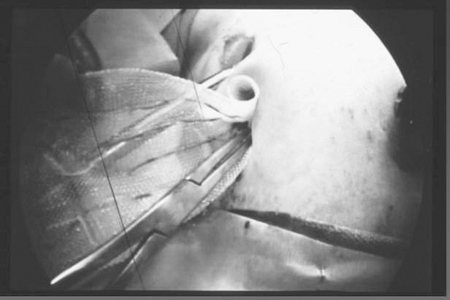 |
Fig. 32-19. Delivery of iodine-125 brachytherapy implant through intercostal access site following thoracoscopic extended wedge resection of peripheral stage I non small cell lung cancer. |
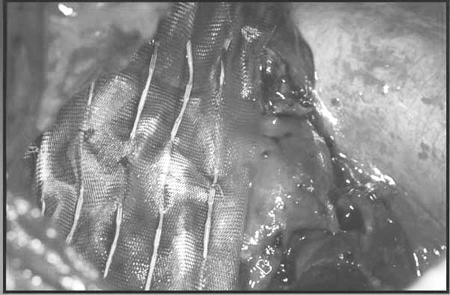 |
Fig. 32-20. Thoracoscopic image of implant over the lung parenchyma. |
P.518
There has been no implant migration, CT scan evidence of radiation fibrosis, or reduction in pulmonary function in longitudinal follow-up of these patients. There have been no implant-related complications. It appears that effective local therapy is able to be delivered immediately at the time of surgery, and the difficulties, inconveniences, and expenses related to postoperative external beam radiation therapy are avoided (Figs. 32-21 and 32-22).
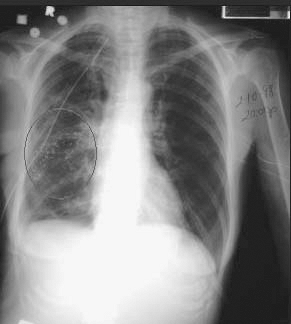 |
Fig. 32-21. Chest radiograph demonstrating the location of the iodine-125 seeds over the line of stapled resection of the lung parenchyma. |
RADIOFREQUENCY ABLATION
For patients with primary or metastatic lung tumors with prohibitive surgical risk, treatment alternatives to surgery include chemotherapy and radiation therapy. These patients also could benefit from minimally invasive ablative therapies that preserve unaffected lung parenchyma, including stereotatic radiation therapy and radiofrequency ablation (RFA), as discussed by Whyte and associates (2003) and by D'Amico (2003).
RFA of lung tumors causes coagulation necrosis of the lesion of interest with a small rim of extension into adjacent normal lung parenchyma. This technique uses radiofrequency energy to generate ionic vibration, which increases tissue temperature to more than 60 C, causing protein denaturation, thermal coagulation, and tissue necrosis, as described by Ahrar (2003) and Gazelle (2000) and their colleagues.
The RFA procedure is performed in the operating room under general anesthesia and approached by minithoracotomy, VATS, or percutaneously, as described by Herrera and colleagues (2003) and by Bhatia (2003). After placement of a small-caliber needle into the center of the lung nodule under CT guidance, a LeVeen needle electrode (Radiotherapeutics Corporation, Sunnyvale, CA), is placed (Fig. 32-23). Several applications in different locations within the lesion may be required for larger masses.
After a mean follow-up of 6 months, 66% of treated patients demonstrated a radiographic response. Reported complications included pneumothorax, pneumonia, pneumonitis, small pleural effusions, hemoptysis, and transient renal failure. Further experience is needed to confirm the results of this approach in high-risk patients.
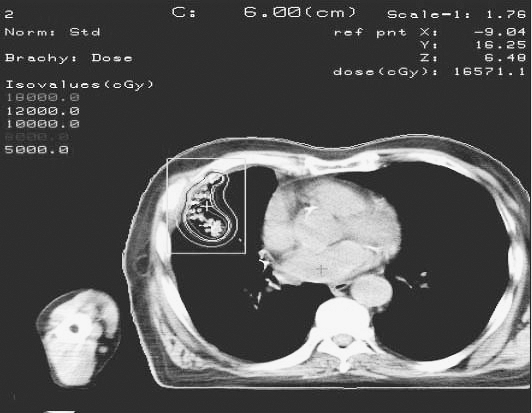 |
Fig. 32-22. Computed tomographic image of the location of the iodine-125 implant (isodose analysis). |
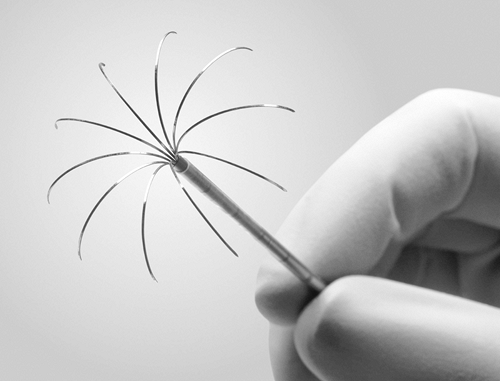 |
Fig. 32-23. RFA LeVeen needle electrode with deployed multitine array. |
P.519
CHEMOPERFUSION OF THE PLEURAL CAVITY
The results of surgical therapy alone or combined with traditional chemotherapy or radiation therapy have been disappointing for patients with mesothelioma, pleural extension from thymic malignancies, and NSCLC with pleural involvement. The standard of care for these malignancies continues to evolve. One strategy is surgical resection of all gross disease with subsequent chemoperfusion of the pleural cavity using a thoracoscopic or an open approach, as described by Shirakusa and Okabayashi (1997) as well as by van Ruth (2003) and de Bree (2002) and their associates. The advantage of this approach is a direct exposure of any residual microscopic disease to higher drug concentrations while minimizing the toxic systemic side effects. Adding hyperthermia to chemoperfusion has been shown in some studies to increase the local tissue and cellular concentrations of the chemotherapy compared with normothermic perfusion. The drug most commonly reported for use in intrapleural hyperthermic chemoperfusion is cisplatin, as discussed by Ratto (1999) and Yellin (2001) and their associates. In most centers, this application is limited to clinical trials, with most of the experience being reported in patients with malignant mesothelioma and thymic malignancies, with less data in the treatment of stage IIIB NSCLC. Further clinical trials will be required to determine the ideal candidates, optimal chemotherapy, and the timing and temperature of the perfusate. Logical requirements for inclusion of patients in these treatment protocols include (a) disease confined to one pleural cavity with no extra thoracic metastases and (b) that gross removal of all local disease is achievable.
APPROACH TO PLEURAL SPACE PROBLEMS
Empyema and Clotted Hemothorax
Thoracic empyema is the collection of pus or the presence of infected fluid within the pleural cavity. The topic was recently reviewed by Angelino-Mackinlay (2000) and one of us (ADH) and Sundaresan (2002). The successful application of thoracoscopy to d bride and drain complex loculated empyemas and clotted hemothoraces was reported by one of us (RJL) and colleagues (1996), Ridley and Braimbridge (1991), and Hutter and associates (1985). Review of appropriate radiographic studies, including plain radiographs and CT scans, is conducted to determine the site of the major pocket or loculation of the empyema. Selection of the appropriate location for placement of the first port may be guided by transthoracic aspiration with a spinal needle. A 10-mm thoracoscopy port is introduced from a dependent direction to this pleural loculation. Specimens are sent for Gram stain, acid-fast stain, routine and anaerobic cultures, as well as cultures for mycobacterium and fungus. Evacuation of the empyema pocket is facilitated by the use of a large-bore (36F to 40F) sucker (Snowden Pencer, Inc., Tucker, GA) to remove the pus and fibrinous debris. Once the pocket is drained, additional intercostal access sites can be established under thoracoscopic guidance and additional instruments introduced. Minor loculations and adhesions are taken down, but areas of thick adhesions between the lung and the chest wall are generally left alone. There is significant risk for injury to the underlying lung when mobilizing adhesions in these areas with resultant bleeding or air leaks, whereas it is unusual for these broad adhesions to be primarily responsible for limiting proper lung reexpansion. When the cause of the pleural process is in question, adequate pleural biopsies are performed to evaluate for infectious agents or malignant etiologies.
VATS can be used with a high degree of success in properly selected patients for d bridement and drainage of empyema. Patients with early empyemas or hemothoraces are excellent candidates for VATS, whereas chronic empyemas should initially be approached by VATS with a low threshold to convert to thoracotomy. In healthy individuals with good performance, every effort should be made to achieve complete drainage and full lung reexpansion. This goal should be accomplished through an open thoracotomy if the VATS approach is unsuccessful. Debilitated patients with significant pleural thickening should be less aggressively approached. VATS and adequate drainage are preferable to a home run attempting full reexpansion of the lung. The morbidity associated with an open decortication may be avoided.
In general, preoperative CT findings are unreliable for predicting which procedure will be necessary to achieve the therapeutic goal. The decision should be made based on intraoperative
P.520
findings. VATS has been successful in up to 98% of empyemas in the fibrinopurulent stage.
VATS has also been successfully employed after failure of fibrinolytic agents to treat parapneumonic empyema, as reported by Bouros and associates (2002), and in postpneumonectomy empyema, as described by Hollaus and colleagues (1999). Similarly, we had excellent results with VATS drainage of clotted hemothoraces (100%) that had failed simple tube thoracostomy drainage, as described by our group and reported by one of us (RJL) and associates (1996). Water-jet lavage has also been used successfully in clotted hemothorax, as reported by Tomaselli and co-workers (2003). In contrast to early empyema and clotted hemothoraces, the chronic empyema is marked by the subacute nature of the inflammatory process, often with a resultant thick and fibrotic pleural peel causing varying degrees of lung entrapment. This fibrotic process is variable, and as we described, in 54% of the chronic empyemas that were approached by VATS, the peel had not yet progressed to the dense fibrotic stage and were successfully decorticated and drained thoracoscopically. This has also been reported by Waller and Rengarajan (2001). The other 46% of chronic empyemas were found to have a thick fibrotic peel that required thoracotomy to decorticate the lung adequately. Experience and appropriate clinical judgment will dictate when a case should be converted to thoracotomy.
VATS techniques are appropriate for complex or loculated empyemas in the acute phase. Empyemas in the subacute phase (about 3 weeks) may still be successfully addressed by VATS techniques in half of the cases. Empyemas that are demonstrated, either on CT scan or intraoperative evaluation, to have an obvious, thickened, fibrotic peel with lung entrapment should be decorticated by open techniques when full reexpansion of the lung is the primary goal. VATS should be used early in the management of the patient with a clotted hemothorax to avoid the sequelae of late fibrothorax or secondary infection of the intrathoracic clot as Mancini and associates (1993) and one of the authors (RJL) (1996) and respective colleagues have outlined.
Table 32-8. Incidence of Common Postoperative Complications after Video-Assisted Thoracic Surgery and Thoracotomy | |||||||||||||||||||||||||||||||||||||||||||||||||||||||||||||||||||||||||||||||||
|---|---|---|---|---|---|---|---|---|---|---|---|---|---|---|---|---|---|---|---|---|---|---|---|---|---|---|---|---|---|---|---|---|---|---|---|---|---|---|---|---|---|---|---|---|---|---|---|---|---|---|---|---|---|---|---|---|---|---|---|---|---|---|---|---|---|---|---|---|---|---|---|---|---|---|---|---|---|---|---|---|---|
| |||||||||||||||||||||||||||||||||||||||||||||||||||||||||||||||||||||||||||||||||
COMPLICATIONS OF VIDEO-ASSISTED THORACIC SURGERY
Complications following VATS procedures have been reviewed Yim and Liu (1996), Inderbitzi and Grillet (1996), and Kaiser and Bavaria (1993), as well as by Hazelrigg (1993b), Jancovici (1996), and Krasna (1996) and their co-workers. These large series include the full spectrum of operations performed with VATS techniques, and common postoperative complications included prolonged air leaks, bleeding, and infection. However, the reported rates of common complications following VATS interventions were similar or less than a historical series of open thoracotomy, as reported by Nagasaki and associates (1982) (Table 32-8).
However, there are several complications specific to VATS. These include complications related to the insertion of thoracoscopy ports, postoperative intercostal neuritis, stapling device failure, and port-site deposition of tumor. As our group has demonstrated, reported by one of us (RJL) and colleagues (1998), thoracoscopy port-related complications can be minimized by always inserting the port under thoracoscopic visualization, using blunt-tipped trocars designed for thoracoscopy, and avoiding the use of sharply pointed laparoscopy ports. The port should be inserted without undue force and always under control; otherwise, the port may pop into the chest blindly with resultant injury to intrathoracic structures. Intercostal neuritis is commonly caused by excessive pressure on the intercostal nerve. This is avoided by placing the skin incision for the port directly over the proposed intercostal space, instead of the more traditional oblique subcutaneous tunnel. This allows for a full 360-degree mobility of the port, reducing the amount of torque on the instruments and the intercostal nerves. Furthermore, excessive spreading of the intercostal soft tissues and the passage of sharp or awkwardly shaped instruments should be minimized or avoided.
Although modern endoscopic stapling techniques are quite reliable, instances of stapler failure have been described. However, the likelihood of stapler failure is increased if the stapler reload is not properly seated or if there are tissue, staples, or other debris left upon the anvil or the hinge
P.521
mechanism of the stapler. Thus, close attention during the reloading process to ensure that the stapler is properly assembled and the anvil is clean can avoid a potential catastrophe.
Deposition and dissemination of tumor cells during VATS with subsequent tumor recurrence has been described as a complication following VATS biopsy of lymph nodes or pulmonary wedge resections. This phenomenon is hardly unique because access-site recurrences have been reported following laparoscopic operations and following VATS for a wide variety of neoplasms, as recently noted by Downey and associates (1996, 1998). Many of these reports are anecdotal, involving a wide range of pathology and surgical techniques. In a review by Collard and Reymond (1996), increased risk for parietal seeding and early local recurrence following VATS for cancer was associated with pulling the neoplastic tissue through a stab incision. Collard and Reymond (1996), Yim and Liu (1996), and Jancovici and associates (1996) all noted an increased risk for local recurrence at the thoracoscopy port sites when a retrieval device (i.e., a glove or bag) was not used. They, along with Krasna and colleagues (1996), further noted that recurrence was more likely in operations when mesothelioma, metastatic sarcoma or melanoma, or malignant pleural effusion was present.
On the other hand, these series have illustrated that many postoperative complications related to thoracic surgery, such as atelectasis, pneumonia, cardiac arrhythmias, or deep venous thrombosis, are found less commonly after VATS than after open thoracotomy. This is likely a benefit of the decreased pain-related morbidity of the operation. As demonstrated by our group and reported by one of us (RJL) and colleagues (1993, 1998), the central appeal of VATS has been the documented decrease of the early postoperative pain and decreased operative morbidity to the chest, back, and shoulder muscles, resulting in decreased requirements for narcotic analgesics, improved pulmonary toilet, and a more expedient return to preoperative level of activities as compared with open techniques.
CONCLUSION
The concept of minimally invasive surgery and VATS has been readily incorporated into the practice of thoracic surgery. Undoubtedly, the decreased postoperative pain and functional disability to the patient following VATS are advantageous compared with conventional thoracotomy approaches. It is well established that most basic and many advanced thoracic surgery procedures can be performed by VATS, with good outcomes and without increased complications. During the past decade, VATS has matured and become the procedure of choice for many general thoracic surgical interventions. As a result, the acceptance of VATS has imposed the need for many thoracic surgeons to acquire this new set of skills in order to perform these operations safely and expediently.
REFERENCES
Acuff TE, et al: Role of mechanical stapling devices in thoracoscopic pulmonary resection. Ann Thorac Surg 56:749, 1993.
Ahrar K, et al: Percutaneous radiofrequency ablation of lung tumors in a large animal model. J Vasc Interv Radiol 14:1037, 2003.
Alexander J: The Collapse Therapy of Pulmonary Tuberculosis. Springfield, IL: Charles C. Thomas, 1937, pp. 313 316.
Allen MS: Interstitial lung diseases. In Yim APC, et al (eds): Minimal Access Cardiothoracic Surgery. Philadelphia: WB Saunders, 2000, pp. 80 84.
Ayed AK, Raghunathan R: Thoracoscopy versus open lung biopsy in the diagnosis of interstitial lung disease: a randomized controlled trial. J R Coll Surg Edinb 45:159, 2000.
Bacchetta MD, et al: Resection of a symptomatic pericardial cyst using the computer-enhanced da Vinci Surgical System. Ann Thorac Surg 75: 1953, 2003.
Benumof JL: Physiology of the open chest and one-lung ventilation. In Kaplan JA (ed): Thoracic Anesthesia. New York: Churchill Livingstone, 1983, pp. 287 316.
Bergquist S, Nordenstam H: Thoracoscopy and pleural biopsy in the diagnosis of pleurisy. Scand J Respir Dis 47:64, 1966.
Bhatia P: Radiofrequency ablation of lung cancer. Thorax 58:771, 2003.
Bouros D, et al: The role of video-assisted thoracoscopic surgery in the treatment of parapneumonic empyema after the failure of fibrinolytics. Surg Endosc 16:151, 2002.
Braimbridge MV: The history of thoracoscopy. Ann Thorac Surg 56:610, 1993.
Brandt HJ: Indikation und Technik der Diagnostischen Thorakoskopie. Atemwegs Lungenkrankh 3:150, 1978.
Burdine J, et al: Feasibility and value of video-assisted thoracoscopic surgery wedge excision of small pulmonary nodules in patients with malignancy. Chest 122:1467, 2002.
Cardillo G, et al: Videothoracoscopic management of the solitary pulmonary nodule: a single-institution study on 429 cases. Ann Thorac Surg 75:1607, 2003.
Cassina PC, et al: Video-assisted thoracoscopy in the treatment of pleural empyema: stage-based management and outcome. J Thorac Cardiovasc Surg 117:234, 1999.
Chang AC, et al: Diagnostic thoracoscopic lung biopsy: an outpatient experience. Ann Thorac Surg 74:1942, 2002.
Chen A, et al: Intraoperative 125I brachytherapy for high-risk stage I non-small cell lung carcinoma. Int J Radiat Oncol Biol Phys 44:1057, 1999.
Collard JM, Reymond MA: Video-assisted thoracic surgery (VATS) for cancer: risk of parietal seeding and of early local recurrence. Int Surg 81: 343, 1996.
Coulaud E, DesChamps P: Decouverte pleuroscopique d'une importante perforation pulmonaire Asymptomatique. Guerison Rapide Spontanee. Rev Tuberculose 11:825, 1947.
d'Amato TA, et al: Intraoperative brachytherapy following thoracoscopic wedge resection of stage I lung cancer. Chest 114:1112, 1998.
D'Amico TA: Local control without resection. J Thorac Cardiovasc Surg 125:787, 2003.
de Bree E, et al: Cytoreductive surgery and intraoperative hyperthermic intrathoracic chemotherapy in patients with malignant pleural mesothelioma or pleural metastases of thymoma. Chest 121:480, 2002.
De Hoyos A, Sundaresan S: Thoracic empyema. Chest Clin North Am 82:643, 2002.
Dendo S, et al: Preoperative localization of small pulmonary lesions with a short hook wire and suture system: experience with 168 procedures. Radiology 225:511, 2002.
Dowling RD, Ferson PF, Landreneau RJ: Thoracoscopic resection of pulmonary metastasis. Chest 102:1450, 1992.
Dowling RD, Wachs ME, Ferson PF: Thoracoscopic Nd:YAG laser resection of pulmonary metastases. Cancer 70:1873, 1993.
Downey RJ: Complications after video-assisted thoracic surgery. Chest Surg Clin N Am 8:907, 1998.
P.522
Downey RJ, McCormack P, LoCicero J: Dissemination of malignant tumors after video-assisted thoracic surgery. J Thorac Cardiovasc Surg 111:954, 1996.
Ferson PF, et al: Thoracoscopic vs. open lung biopsy for the diagnosis of infiltrate lung disease. J Thorac Cardiovasc Surg 106:194, 1993.
Fourestier M, Duret M: Necessite de la biopsie pleurale pour le diagnostic de L'endotheliome de la plevre. Presse Med 32:467, 1943.
Gazelle GS, et al: Tumor ablation with radiofrequency energy. Radiology 217:633, 2000.
Ginsberg RJ, Rubinstein LV: Randomized trial of lobectomy versus limited resection for T1 N0 non-small cell lung cancer. Lung Cancer Study Group, Ann Thorac Surg 60:615, 1995.
Ginsberg MS, et al: Pulmonary nodules resected at video-assisted thoracoscopic surgery: etiology in 426 patients. Radiology 219:277, 1999.
Hazelrigg SR, et al: The effect of muscle sparing versus standard posterior-lateral thoracotomy on pulmonary function, muscle strength, and postoperative pain. J Thorac Cardiovasc Surg 101:394, 1991.
Hazelrigg SR, et al: Cost analysis for thoracoscopy: thoracoscopic wedge resection. Ann Thorac Surg 56:633, 1993a.
Hazelrigg SR, et al: Video Assisted Thoracic Surgery Study Group data. Ann Thorac Surg 56:1039, 1993b.
Herrera LJ, et al: Radiofrequency ablation of pulmonary malignant tumors in nonsurgical candidates. J Thorac Cardiovasc Surg 125:929, 2003.
Hollaus PH, et al: Videothoracoscopic debridement of the postpneumonectomy space in empyema. Eur J Cardiothorac Surg 16:283, 1999.
Hutter JA, Harari D, Baimbridge MV: The management of empyema thoracis by thoracoscopy and irrigation. Ann Thorac Surg 39:517, 1985.
Inderbitzi RG, Grillet MP: Risk and hazards of video-thoracoscopic surgery: a collective review. Eur J Cardiothorac Surg 10:483, 1996.
Jacobeus HC: Possibility of the use of cystoscope for the investigation of the serous cavities. Munch Med Wochenschr 57:2090, 1910.
Jacobeus HC: The practical importance of thoracoscopy in surgery of the chest. Surg Gynecol Obstet 34:289, 1922.
Jacobeus HC: Die Thorakoskopie und ihre praktische Bedeutung. Ergebn Ges Med 7:112, 1925.
Jancovici R, et al: Complications of video-assisted thoracic surgery: a five year experience. Ann Thorac Surg 61:533, 1996.
Jimenez MF: Spanish Video-Assisted Thoracic Surgery Study Group. Prospective study on video-assisted thoracoscopic surgery in the resection of pulmonary nodules: 209 cases from the Spanish Video-Assisted Thoracic Surgery Study Group. Eur J Cardiothorac Surg 19:562, 2001.
Kadokura M, et al: Pathologic comparison of video-assisted thoracic surgical lung biopsy with traditional open lung biopsy. J Thorac Cardiovasc Surg 109:494. 1995.
Kaiser LR, Bavaria JE: Complications of thoracoscopy. Ann Thorac Surg 56:796, 1993.
Keenan RJ, et al: Video-assisted thoracic surgical resection with the neodymium:yttrium-aluminum-garnet laser. J Thorac Cardiovasc Surg 110:363, 1995.
Kirby TJ, et al: Video-assisted thoracic surgery versus muscle-sparing thoracotomy. A randomized trial. J Thorac Cardiovasc Surg 109:997, 1995.
Krasna MJ, Deshmukh S, McLaughlin JS: Complications of thoracoscopy. Ann Thorac Surg 61:1066, 1996.
Landreneau RJ, et al: Nd:YAG laser assisted pulmonary resections. Ann Thorac Surg 51:973, 1991a.
Landreneau RJ, et al: Thoracoscopic Nd:YAG laser assisted pulmonary resection. Ann Thorac Surg 52:1176, 1991b.
Landreneau RJ, et al: Thoracoscopic resection of 85 pulmonary lesions. Ann Thorac Surg 54:415, 1992a.
Landreneau RJ, et al: Video-assisted thoracic surgery: basic technical concepts and intercostal approach strategies. Ann Thorac Surg 54:800, 1992b.
Landreneau RJ, et al: Thoracoscopic resection of an anterior mediastinal tumor. Ann Thorac Surg 54:142, 1992c.
Landreneau RJ, et al: Strategic planning for video-assisted thoracic surgery. Ann Thorac Surg 56:615, 1993a.
Landreneau RJ, et al: Differences in postoperative pain, shoulder function, and morbidity between video-assisted thoracic surgery and muscle sparing open thoracotomies. Ann Thorac Surg 56:1285, 1993b.
Landreneau RJ, et al: Postoperative pain-related morbidity: video-assisted thoracic surgery versus thoracotomy. Ann Thorac Surg 56:1285, 1993c.
Landreneau RJ, et al: VATS wedge resection of the lung using the neodymium:yttrium-aluminum garnet laser. Ann Thorac Surg 56:758, 1993d.
Landreneau RJ, et al: Prevalence of chronic pain after pulmonary resection by thoracotomy or video-assisted thoracic surgery. J Thorac Cardiovasc Surg 107:1079, 1994.
Landreneau RJ, et al: Thoracoscopy for empyema and hemothorax. Chest 109:18, 1996.
Landreneau RJ, et al: Wedge resection versus lobectomy for stage I (T1N0M0) non-small cell lung cancer. J Thorac Cardiovasc Surg 113: 691, 1997.
Landreneau RJ, et al: Effect of minimally invasive approaches on acute and chronic postoperative pain. Chest Surg Clin N Am 8:891, 1998.
Lazopoulos G, et al: A Diagnostic mini-video assisted thoracic surgery. Effectiveness and accuracy of new generation 2.0 mm instruments. Surg Endosc 16:1793, 2002.
Lewis RJ, Caccavale RJ: Video-assisted thoracic surgical non-rib-spreading simultaneously stapled lobectomy. In Yim APC, et al (eds): Minimal Access Cardiothoracic Surgery. Philadelphia: WB Saunders, 2000, pp. 135 151.
Lewis RJ, Caccavale RJ, Sisler GE: Surgical treatment of diffuse end-stage bilateral bullous disease of the lung using video-assisted thoracic surgery and the argon beam coagulator. Ann Thorac Surg 55:1394, 1993.
Li WW, et al: The impact of thoracic surgical access on early shoulder function: video-assisted thoracic surgery versus posterolateral thoracotomy. Eur J Cardiothorac Surg 23:390, 2003.
Lillington GA: Solitary pulmonary nodules: new wine in old bottles. Curr Opin Pulm Med 7:242, 2001.
LoCicero J III, et al: Experimental air leak in lung sealed by low-energy carbon dioxide laser irradiation. Chest 87:820, 1985.
LoCicero J III, et al: Laser-assisted parenchymal sparing pulmonary resection. J Thorac Cardiovasc Surg 97:732, 1989.
Low JM: Anesthesia for video-assisted thoracic surgery. In Yim APC, et al (eds): Minimal Access Cardiothoracic Surgery. Philadelphia: WB Saunders, 2000, pp. 21 27.
Luketich JD, et al: Minimally invasive esophagectomy. Ann Thorac Surg 70:906, 2000.
Mack MJ, et al: Techniques for localization of pulmonary nodules for thoracoscopic resection. J Thorac Cardiovasc Surg 106:550, 1993.
MacKinley GA: Empyema and hemothorax. In Yim APC, et al (eds): Minimal Access Cardiothoracic Surgery. Philadelphia: WB Saunders, 2000, pp. 48 57.
Mancini M, et al: Early evacuation of clotted blood in hemothorax using thoracoscopy. J Trauma 34:144, 1993.
Mantegazza R, et al: Video-assisted thoracoscopic extended thymectomy and extended transsternal thymectomy (T-3b) in non-thymomatous myasthenia gravis patients: remission after 6 years of follow-up. J Neurolog Sci 212:31, 2003.
Melendez JA, Fischer ME: Preoperative pulmonary evaluation of the thoracic surgical patient. Chest Surg Clin N Am 7:641, 1997.
Melfi FM, et al: Early experience with robotic technology for thoracoscopic surgery. Eur J Cardiothorac Surg 21:864, 2002.
Meyer DM: Preoperative assessment for video-assisted thoracic surgery. In Yim APC, et al (eds): Minimal Access Cardiothoracic Surgery. Philadelphia: WB Saunders, 2000, pp. 11 20.
Miller JI, Hatcher CR Jr: Limited resection of bronchogenic carcinoma in the patient with marked impairment of pulmonary function. Ann Thorac Surg 44:340, 1987.
Miller JD, et al: A randomized, controlled trial comparing thoracoscopy and limited thoracotomy for lung biopsy in interstitial lung disease. Ann Thorac Surg 70:1647, 2000.
Mineo TC, et al: Thoracoscopic thymectomy in autoimmune myasthenia gravis: results of left-sided approach. Ann Thorac Surg 69:1537, 2000.
Mitruka S, et al: Diagnosing the indeterminate pulmonary nodule: percutaneous biopsy versus thoracoscopy. Surgery 118:676, 1995.
Morgan JA, et al: Advanced thoracoscopic procedures are facilitated by computer-aided robotic technology. Eur J Cardiothorac Surg 23:883, 2003.
Nagasaki F, Flehinger BJ, Martini N: Complications of surgery in the treatment of carcinoma of the lung. Chest 82:25, 1982.
Nakata M, et al: Prospective study of thoracoscopic limited resection for ground-glass opacity selected by computed tomography. Ann Thorac Surg 75:1601, 2003.
Okada S, et al: Thoracoscopic lung resection for a peripheral lung cancer by a single surgeon with a voice-controlled robot. Kyobu Geka 54:968, 2001.
Ost D, Fein AM, Feinsilver SH: Clinical practice. The solitary pulmonary nodule. N Engl J Med 348:2535, 2003.
P.523
Parekh K, et al: VATS port site recurrence: a technique dependent problem. Ann Surg Oncol 8:175, 2001.
Partik BL, et al: Using a dedicated lung-marker system for localization of pulmonary nodules before thoracoscopic surgery. AJR Am J Roentgenol 180:805, 2003.
Ratto GB, et al: Pleural space perfusion with cisplatin in the multimodality treatment of malignant mesothelioma: a feasibility and pharmacokinetic study. J Thorac Cardiovasc Surg 117:759, 1999.
Ridley PD, Braimbridge MV: Thoracoscopic debridement and pleural irrigation in the management of empyema thoracis. Ann Thorac Surg 51:461, 1991.
Roviaro GC, et al: State of the art in thoracoscopic surgery: a personal experience of 2000 videothoracoscopic procedures and an overview of the literature. Surg Endosc 16:881, 2002.
Russo L, et al: The safety and efficacy of immediate chest tube removal following VATS wedge resection of the lung. Ann Thorac Surg 66:1751, 1998.
Ruurda JP, et al: Robot-assisted thoracoscopic resection of a benign mediastinal neurogenic tumor: technical note. Neurosurgery 52:462, 2002.
Santos RS, et al: Comparison between sublobar resection and 125iodine brachytherapy following sublobar resection in high-risk patients with stage I non-small cell lung cancer. Surgery 134:691, 2003.
Sawabata N, et al: In vitro comparison between argon beam coagulation and Nd:YAG laser in lung contraction therapy. Ann Thorac Surg 62: 1485, 1996.
Schwartz RE, et al: Needle localization thoracoscopic resection (NLTR) of indeterminate pulmonary nodules: impact on management of patients with malignant disease. Ann Surg Oncol 2:49, 1994.
Shirakusa T, Okabayashi K: Video-assisted thoracic surgery for lung cancer. Gan To Kagaku Ryoho 24:520, 1997.
Stammberger U, et al: Early and long-term complaints following video-assisted thoracoscopic surgery: evaluation in 173 patients. Eur J Cardiothorac Surg 18:7, 2000.
Swierenga J, Wagenaar JP, Bergstein PG: The value of thoracoscopy in the diagnosis and treatment of diseases affecting the pleura and the lung. Pneumologie 151:11, 1974.
Tan BB, et al: The solitary pulmonary nodule. Chest 123:89S, 2003.
Temes RT, et al: The lingula is an appropriate site for lung biopsy. Ann Thorac Surg 69:1016, 2000.
Teplick R: Preoperative cardiac assessment of the thoracic surgical patient. Chest Surg Clin N Am 7:655, 1997.
Tomaselli F, et al: Thoracoscopic water jet lavage in coagulated hemothorax. Eur J Cardiothorac Surg 23:424, 2003.
van Ruth S, et al: Cytoreductive surgery combined with intraoperative hyperthermic intrathoracic chemotherapy for stage I malignant pleural mesothelioma. Ann Surg Oncol 10:176, 2003.
Waller DA, Rengarajan A: Thoracoscopic decortication: a role for video-assisted surgery in chronic postpneumonic pleural empyema. Ann Thorac Surg 71:1813, 2001.
Wernly JA, DeMeester TR: Preoperative assessment of patients undergoing lung resection for cancer. In Roth JA, Ruckedeschel JC, Weisenburger TH (eds): Thoracic Oncology. Philadelphia: WB Saunders, 1989, pp. 156 176.
Whyte RI, et al: Stereotactic radiosurgery for lung tumors: preliminary report of a phase I trial. Ann Thorac Surg 75:1097, 2003.
Wilson RS: Lung isolation, tube design, and technical approaches. Chest Surg Clin N Am 7:735, 1997.
Worsey J, Landreneau RJ: Approach strategies and special instrumentation for thoracic surgery. In Manncke K, Rosin RD (eds): Minimal Access Thoracic Surgery. Philadelphia: Chapman and Hall Medical, Lippincott-Raven, 1998, pp. 39 52.
Yellin A, et al: Hyperthermic pleural perfusion with cisplatin: early clinical experience. Cancer 92:2197, 2001.
Yim APC: Paradigm shift in surgical approaches to thymectomy. Aust N Z J Surg 72:40, 2002.
Yim APC, Liu HP: Complications and failures of video-assisted thoracic surgery: experience from two centers in Asia. Ann Thorac Surg 61:538, 1996.
Yim AP, et al: Place of video-thoracoscopy in thoracic surgical practice. World J Surg 25:157, 2001.
EAN: 2147483647
Pages: 203